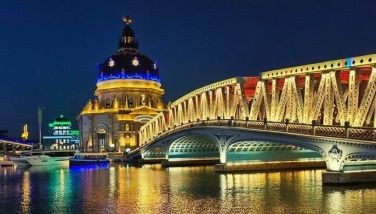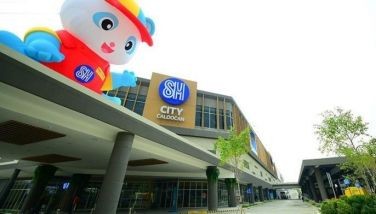Once upon a fascinating Manila

Rummaging through my collection of pre-war (WWII) books I found a book that has gone missing since I rearranged my furniture — to make way for more books.
The publication was a not a travelogue but contained material on Manila and other destinations addressing a tourism angle. The book, published in 1939 by the Department of Agriculture and Commerce was blandly titled Facts and Figures About the Philippines. The pictures of Manila and points in the Philippines inside, however, are fascinating, especially as seen from our point of view 74 years hence.
The section on Manila and tourism destinations was short but painted a wonderful picture of the capital and points of interest outside of it at the time. It starts, “In a setting of verdant tropical islands and turquoise sea, Manila stands out vividly among the glamorous cities of the Far East. Aptly called the ‘Pearl of the Orient,’ Manila has much in beauty and brilliancy to offer to a fastidious tourist.â€
The geographical description of the article is instructive even today, as many Metro Manilans forget the physical and historical context of the metropolis: “Manila, the capital city of the Philippines, is situated, on the west central coast of the Island of Luzon at the eastern and inner shore of Manila Bay, famous in history as the scene of Admiral Dewey’s victory in 1898. It has been built athwart the mouth of the Pasig River, outlet to Laguna de Bay, a large lake 20 miles in the interior. It is the leading commercial and industrial center of the Archipelago, being the distributing point for the Islands’ foreign and domestic trade. Here are located the principal offices and factories of the different nationalities doing business in the Philippines.â€
Continuing on Manila, “From a tiny bamboo-barricaded fishing village that it was in 1571, Manila has grown into one of the most fascinating places in the Far East. Manila exhibits three distinct types of cultural and industrial development, the ancient oriental, the mediaeval, and the modern. Tondo, representing the ancient oriental, is the native district in which the vestiges of primitive life are still discernible. This is the most populous part of Manila and the home of a large part of the laboring class. Flimsy nipa shacks predominate in the district.â€
“The medieval is represented by Intramuros, or the Walled City, formerly the capital of the Philippines. It is an ancient city splendidly preserved, a memento of a romantic, glamorous past, it is essentially a city of convents, monasteries, chapels, and churches, all hundreds of years old.â€
A description of 1939 Manila shows its improvements from the first few decades of the 20th century: “Modern Manila boasts of acacia-and-mango bordered streets and broad asphalted avenues, stately public buildings, imposing residences, bustling factories, fine universities and schools, and well-kept gardens and parks. Truly, Manila is a city of many interesting and picturesque contrasts ranging all the way from flimsy huts, mediaeval Spanish churches, and quaint carabao carts, comely women in gauzy, lovely native dresses to tall concrete edifices, swanky flaming limousines, smart night clubs, and sophisticated swing music. Here the old blends with. the new, and the East meets the West to produce a delightful, scintillating kaleidoscope not lo be found elsewhere and which, will have an irresistible appeal, to the visitor frown far-away lands.â€
Even back then our warmth as a people was noted as distinctive: “The Philippines is a hospitable country where you are welcomed with a handshake of friendship and a sweet smile. From the moment you walk down the corridors of Pier Seven, one of the world’s largest and finest piers (unlike today’s world’s worst terminal – NAIA I), to the time of your departure, you become one of a large family of happy, contented people in love with life and vibrantly alive to the real pleasures of living. Here you forget the helter and skelter of the busy business world and drop the bundle of cares and worries that has been saddling you for so long. The friendliness of the people is refreshing. Here utter peace is yours throughout a succession of lush, leisured days. You, like the many visitors that have come to these Islands of perpetual summer, leave with that exquisite feeling of having really enjoyed a ‘lovely’ time.â€
The section also brings readers on trips out of Manila: “Within easy motoring distances from Manila are numerous places of interest to the traveller’s; places of great natural beauty, of historic value, and of picturesque views of Philippine country life.
Of these the following are recommended: The historic ruins of the old Guadalupe monastery and church built 300 years ago by the Spaniards and the scene of a battle between American and Filipino troops during the revolution of 1898-1900, after which it was burned; Fort McKinley, on the Pasig River, the largest military reservation under the American flag; Antipolo, a hilly village with an ancient church whose chief treasure is a silver statue of the Virgin (Our Lady of Good Voyages) studded with 8250,000 worth of jewels; Montalban Gorge, source of Manila water supply, and the near-by cave of bats; Cavite Naval Station, headquarters of the 16th United States Naval District and headquarters of the US Asiatic Fleet from December to May; Las Pifias, in whose church is seen the famous bamboo organ built 100 years ago, entirely of bamboo without any metal or other material, the only one of its kind in the world; Tagaytay, with its beautiful panorama of sea. and plain, rugged mountain valleys, and marvelous view of Lake Taal and Taal Volcano, rivaling the famous scenic views from the Peak at hongkong and at Pa]i, Honolulu; Balete, on the shore of Lake Taal, from which the resthouse management conducts motorboat excursions across the lake to Taal Volcano; Los Bafios, with its Maquiling Botanical Garden, containing specimens of trees, plants, shrubs, and flowers of the Philippines; Sibul Springs and Pandi, both in Bulacan, famous for their remarkable springs of mineral, water; Atimonan, with its long stretches of palm-fringed beaches, where one will. find a glimpse of his dreams of the South Seas.â€
The sections also lists other destinations in the archipelago: “ Baguio: Located among the pine-clad mountains of Benguet, Baguio is the most widely known and popular resort in the Philippines. It is 75 miles from Manila or about six hours travel by auto. Nestling in the mountains 5,000 feet above sea level and with a climate ranging from -1. to 27° C., it is aptly described as the wonderland of the Orient….The city is most beautifully and picturesquely laid out on an expansive scale among pine-clad surroundings, and. is provided with good hotels, recreation grounds, tennis courts, golf courses, and a fine country club. Its principal points of interest are the public market, Camp John Hay (military reservation), Teachers’ Camp, Mount Mirador, Burnham Park, and the numerous gold mines near-by.â€
Next mentioned was Pagsanjan Falls:†The Pagsanjan Gorge and Rapids located in the province of Laguna have no equal in the Far East. The rapids drop over a tall cliff in a double fall of rare beauty. Below the falls they race madly over the rocks through, a narrow gorge whose towering cliffs are covered with tropic, jungle growths. Travelers ascend the river in native canoes paddled by two boatmen, and after a swim in the pool at the foot of the fall they shoot the rapids in a swift and thrilling return.â€
Cebu (hit recently by that strong earthquake) made the list of course: “Cebu is 392 miles from Manila and is 26 trouts sailing distance from it. It is the oldest European city of the Philippines, having been founded in 1565. Among its interesting points are the historic churches, Magellan’s cross, fresh-water pools on Talisay beach, Calle Colon (the oldest city street in the Philippines), Liloan Beach Club, and Port San Pedro. Outside the City are equally interesting places throughout the rural districts of the island of Cebu. An excursion by launch may take one to the island of Mactan, where Magellan met his death on April 26, 1521, and whose body was never —recovered in spite of the large ransom offered by the Spanish government for its return. Interesting souvenirs of Cebu are the round-bodied ukeleles made of polished coconut shells, guitars made of various Philippine hardwoods, wooden slippers, and other articles which are inexpensive mementos.â€
Iloilo, Zamboanga, Davao, Jolo and Sulu rounded the list: “Iloilo is the business center of the Island. of Panay, 340 miles from Manila, and 17 hours sailing distance from it. It is a seaport and the shipping center of the Western Visayas. Fine motor roads and a railroad system traverse the island of Panay from the City of Iloilo, and interesting views may be had of Philippine agriculture and village life. The Island of Negros is near, being a two-hour ferry boat trip. A trip to the sugar centrals and sugar haciendas of this island will also prove to be of particular interest.â€
â€Zamboanga is the biggest city in the world in point of area. It as a total area of 2,348.01 square kilometers, which is bigger than that of London. It is 512 miles, and 48 hours sailing distance from Manila. Zamboanga is picturesquely situated, with a hill slope rising gently behind it, and beyond lie mountains of 3,000 to 5,000 feet. There are few other places where there can be seen a greater mixture of races and picturesque people than in Zamboanga. Here are Moros in many varieties of costume with the ubiquitous fez and the women gaily bedecked, bejewelled, and trousered.
“Zamboanga fulfils every desire of the seeker for the far-famed South Sea lure. The romance among this cosmopolitan population is so enchanting that it has given birth to that soulful Spanish tune, ‘No te vayas a Zamboanga que me puedas olvidar,’ which has become a legend among travelers to that wonderful and refreshing city.
“Davao, the center of a new agricultural empire in the Philippines, is 774 miles from Manila and is situated on the southernmost part of Mindanao. Davao is a beautiful, thriving city with paved streets, business houses, and busy markets. The Province of Davao is the premiere abaca-producing region in the Philippines. It has also extensive coconut plantations and vast forests. Visitors should not fail to drive into this place to see the abaca plantations and the various processes of hemp stripping.
“The island of Sulu, with its capilal Jolo, is the real home of the Moros Mohammedan Filipinos). It is 540 miles from Manila, and 85 miles from Zamboanga. Jolo is a tropic paradise removed from the rest of the world, where Moro life goes on much as in the days of their forefathers. It is the home of the Sultan of Sulu who nominally holds sway over Philippine Moros and. maintains his court, while the affairs of the government are administered by a governor elected by the people. The island is mainly inhabited by Moros who live by fishing. Jolo is a famous pearl center, and has a thriving pearl-fishing industry. Likewise, it is famous for its unique trinkets and wares, the products of Moro artistry and handicraft.â€
Reading these descriptions and seeing the pictures convinced many to visit the islands. Much of what made our country attractive is still here, although we have lost many landmarks to natural disasters and the foolishness of un-thinking “development.†We all wish that this continuing loss will end and that those areas, and the people that have suffered in them, will recover and welcome us all to their fascinating homes.â€
* * *
Feedback is welcome. Please e-mail the writer at paulo.alcazaren@gmail.com.



















